A Surveyor should always look in the roof
Review of a structural survey with
roof problems
Advice from a building surveyor
We can provide help and advice with regard to building surveys, structural surveys, structural reports, independent valuations, property surveys, engineers reports, specific defects report, home buyers reports or any other property matters on any age, type and style of property . We would be happy to email you examples of our survey reports.
Free phone 0800 298 5424 for independent surveying advice.
A problem with the roof can often indicate problems with the whole building
If you have roof problems you usually have problems with the whole building. In our experience of carrying out structural surveys if there are problems with the roof in the form of movement or letting dampness in then there tends to be problems with the whole building as the roof affects the rest of the building.
Surveyors should inspect the roof space
We feel that a surveyor doing either a building survey or a structural survey should always go in the roof as this is the only way to identify if there are problems with the roof structure. We are forever amazed at surveyors that don't go in roofs and we are well aware that the new Valuation requirement for surveyors means that you don't even have to open the loft hatch. .

Other surveying articles that may be of interest
We have written many articles on all aspects of property issues. The following articles give further information in relation to roofs:
Common pitched roofs
Roof problems
Problems with builders on roofs
Dormer roofs
Roof structures
Meet the building surveyor at the property
We would always recommend if you have the time and can get to the property whilst the survey is being carried out that you meet your independent surveyor who will be more than happy to talk to you about any concerns and possible problems that you think the property may have together with any potential alterations and improvements that you may be looking to carry out to the property. We will, of course, also be happy to speak to you about the survey report once it has been completed.

Check the condition of the roof structure
As we have mentioned, if you have roof problems you usually have problems with the whole building therefore it is very important that the surveyor views the roof space. In this instance f rom our inspection in the roof we noted that the common rafters (the ones that form the pitch of the roof) are very small compared with what we typically see.
We could see that the roof structure had had work carried out to it in the form of adding RSJ's ( rolled steel joists), also known as I beams which would have required the removal of the roof.
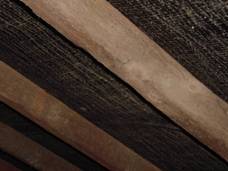
Rafters thinner than usual
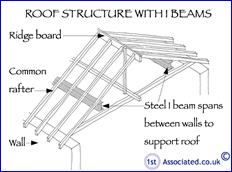
Roof with I beams
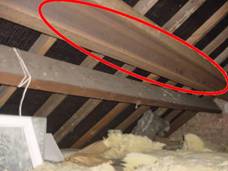
Extra purlin added
What else did the survey uncover?
As well as the main issue of the roof problems our surveyor uncovered some other issues:
Deflection to first floor
The first floor deflected far more than we would expect indicating that the joists are undersized or there are problems with the end of the joists where they are bedded into the walls, possibly from dampness.
Initially the ceiling should be opened up to check the condition and size of the timbers. A spine beam could be added to the floor to give extra strength or to take out the existing joists and replace or put new timbers back to back with existing timbers would probably be easier.
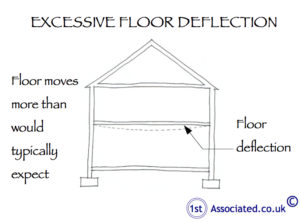
Excessive deflection
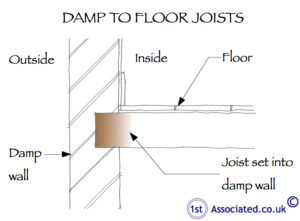
Damp in embedded timbers
There seems to be a fundamental problem with the strength of the structure when you consider this in line with the alterations that have been carried out within the roof. Many people would be put off buying the property because of this.
Fascias and soffits overcladding asbestos
In this case the plastic fascias and soffits are overcladding the original asbestos fascias and soffits. We would recommend complete replacement and removal of any asbestos.
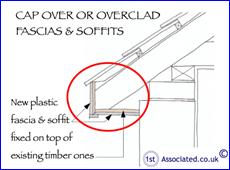
Overclad fascias and soffits
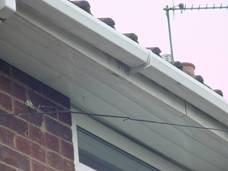
Damp in embedded timbers
This property was built around the War Years when asbestos was a very commonly used material. Asbestos may be elsewhere throughout the property in such areas shown in the sketches below.
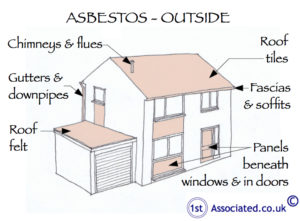
Potential asbestos outside
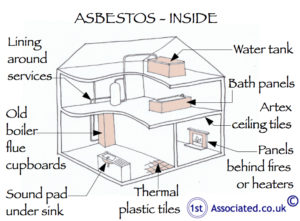
Potential asbestos inside
Cold Bridging
This era of property can particularly suffer from cold bridging.
Cold Bridging Defined
Cold bridging is caused by a colder element in the structure allowing coldness to pass through the structure much quicker when warm moist air is present in the property, often caused by things like having a shower or a bath, cooking or washing, particularly if you are drying washing on the radiators. This is also caused by the general climate which results in condensation on the element.
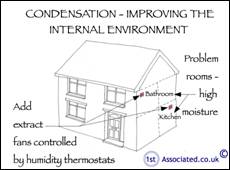
Cold bridging
There are various elements within this property which mean that cold bridging is likely.
1) Concrete surrounds around the windows
2) Concrete lintels
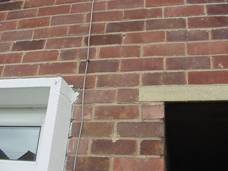
Concrete lintels and concrete
surround around windows
Cold bridging/condensation
Cold bridging makes condensation problems more likely therefore it is particularly important that humidity creating areas such as the kitchen and bathroom have large humidity controlled extract fans.
Thinking of having a survey?
If you are thinking of buying a property and are interested in having a Structural Survey carried out or if you are trying to sell a property and would like a Pre-Sales Survey please call us on free phone us for a friendly chat on 0800 298 5424. We would be happy to email you several examples of our tailor made reports. We have carried out surveys on many different types of properties.
All rights of this article are reserved to www.1stAssociated.co.uk
